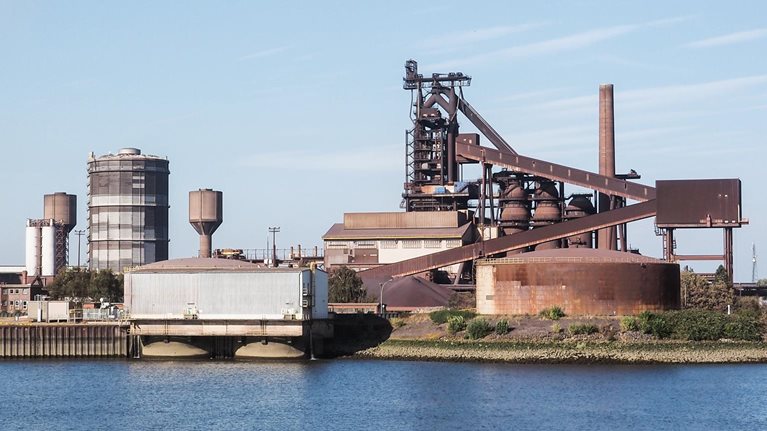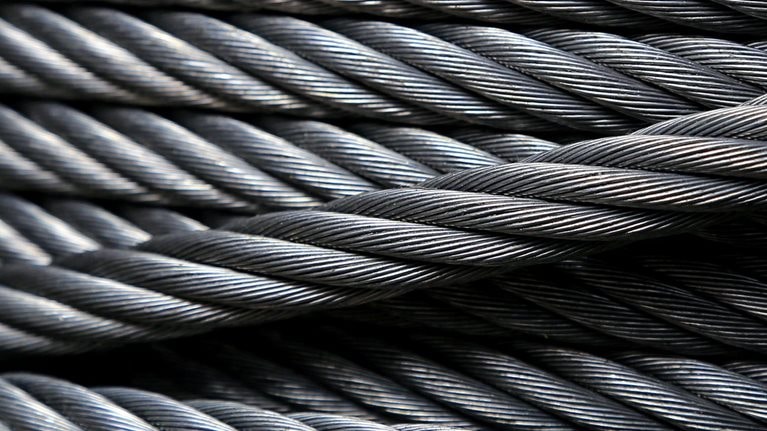The European steel industry is facing a fundamental challenge that will disrupt core steel production processes across the continent. Across the world (but particularly in Europe), steel companies are facing increasing pressure—from regulators, customers, investors, and society at large—to decarbonize production. The majority of flat-steel companies in Europe have announced 2030 decarbonization targets, with most aiming to lower emissions by at least 30 percent from 2018–19 levels.1
Simply recycling scrap will not be sufficient to meet steel demand in terms of either quantity or quality; for this reason, most steel companies are also looking to use direct reduced iron (DRI). Steel producers have two DRI procurement options: they can source it straight from the plant in the form of hot DRI (HDRI), or they can buy hot briquetted DRI (HBI) from overseas.
The crucial determinant of the relative cost competitiveness of these two sourcing options will be the medium-term cost and price of green hydrogen, which depend on the cost and availability of renewable-energy sources. This link introduces considerable uncertainty into the overall economic calculus and demonstrates that a scenario analysis is the best way to gain real insight into cost drivers. Our analysis, which also considers differing process and transportation costs, suggests that the European production of HDRI can be competitive at a global level, though this depends heavily on the availability of green hydrogen at economical prices.
However, each steel producer will still need to consider their own company strategy, as well as broader industry and geopolitical trends, before coming to a decision. Companies will need to understand the likely development of European and global renewable-power supply and competing demands; rethink business models and create new green ecosystems; and consider how to diversify and derisk their chosen sourcing strategy.
Decarbonization represents a huge challenge for steel companies. For those that are thoughtful about the coming change and can adapt, however, decarbonization can also present an opportunity to capture value and future-proof their company strategies.
DRI offers a possible path to decarbonization, but local production may be a challenge
As discussed in a previous McKinsey article, the steel industry is currently among the three largest emitters of CO2 globally.2 Growing investor and public interest in sustainability, stronger carbon emission regulations, and changing customer requirements and preferences show how steel companies are increasingly facing a decarbonization challenge. Recent studies estimate that the global steel industry may find that approximately 14 percent of steel companies’ potential value is at risk if they are unable to decrease their environmental impact.3
A significant technological overhaul will therefore be required to shift the steel industry away from high-emission, coal-based production processes. Although the increased usage of scrap can contribute to decarbonizing existing crude-steel production routes, future steel production cannot be based solely on circular raw-material flows. More than half of the metallics sourced for global steel production until 2040 will need to come from DRI or pig iron (Exhibit 1). In addition to the shortfall in quantity, the quality of available scrap would likely not allow European steel producers to continue offering the complete portfolio of high-quality steel products they are producing today.

When recycling scrap is not sufficient, most companies plan to close their green-metallics supply gap using DRI and an electric melter. There are two types of furnaces: the electric arc furnace (EAF) produces steel directly and is currently mainly used to produce long steel; the open slag bath furnace (OSBF)4 is similar to a blast furnace and produces hot metal. The latter furnace is currently rarely used for iron and steel production but does have other applications in the metals industry, such as in the production of ferroalloys.
As of November 2022, approximately 24 DRI projects, totaling around 40 to 50 metric megatons (Mt) of DRI capacity, have been announced. They are located primarily in Western and Northern Europe (Exhibit 2). Using green hydrogen to power the iron reduction process would allow flat-steel companies to achieve a CO2 footprint below 0.60 metric tons (t) of CO2 per t of flat steel. This would represent a significant reduction from 2019, when every t of steel produced emitted an average of 1.85 t of CO2.5

Europe’s ability to shift production to hydrogen DRI cannot be taken for granted. About 50 to 70 kilograms (kg) of hydrogen are needed to produce one t of DRI. This conversion rate means that the 40 Mt of DRI capacity of the 24 DRI plants laid out in Exhibit 2 are likely to require about two Mt of hydrogen—or 10 percent of projected European hydrogen demand in 2030—every year.6
Expected challenges related to using European green hydrogen include sourcing green electricity and dealing with possible increases in hydrogen prices. In addition, many steel companies had been planning to use natural gas as a transitionary feedstock in the first years of decarbonization while local DRI production capacity was ramping up, but continued volatility in the European natural-gas market may make this transition path unviable.
As a result, steel companies should not pin all their hopes on local DRI production. They will need to consider alternative sourcing options and compare the advantages, disadvantages, and risks of the various routes open to them.
Companies will need to weigh the advantages of HDRI and HBI carefully
Steel producers have two sourcing options for DRI-based steel production. The first option involves melting DRI when it leaves the DRI unit in the form of HDRI. In this way, a producer integrates DRI production into the steelmaking process. The second option is to feed the melters with HBI, which is cold, compacted, and passivated for travel. This second route allows DRI production and steelmaking to be decoupled.
Three separate economic dimensions will need to be considered when assessing the future competitiveness of European HDRI production against importing HBI from further afield.
- The cost and availability of local green power for hydrogen production. Hydrogen production—and therefore supply—will depend on the future availability of (green) electricity for electrolysis and hydrogen production infrastructure. Meeting the power demand for announced DRI capacity with renewables could require, for example, more than 6 percent of 2030 renewable generation capacity in Germany and up to 16 percent in Sweden (Exhibit 3). Uncertainty about the future of renewable-electricity production and competing demands means the competitiveness of European hydrogen supply is best assessed on a scenario basis.
- Cost savings from an integrated steel-making process. Use of cold HBI requires about 100 to 150 additional kilowatt hours of energy per t to melt, as compared to HDRI. Therefore, the integrated HDRI process both reduces cost and creates higher melter productivity.
- Transportation and briquetting cost. Transporting HBI costs about the same as transporting iron ore pellets for conversion into HDRI, so there will be a difference in pure transportation costs only if HBI shipping takes place on top of, rather than instead of, ore shipping. When assessing total transportation costs, however, steel companies will also need to consider the additional HBI handling and loading costs and the costs related to the briquetting (passivation) required before transportation.

HBI versus HDRI: Two sourcing scenarios for Europe’s DRI plants
The uncertainty of the medium-term cost and price of both hydrogen and green power means that assessing relative competitiveness requires a scenario analysis and several assumptions. In the analysis that follows, we compare a plausible local European HDRI scenario with an imported HBI scenario. We use optimistic assumptions about the price and availability of hydrogen and other important economic factors for both scenarios.
- Local European HDRI scenario. DRI is produced locally at European steel mills using local green hydrogen supplied by short- to medium-distance pipelines. Hydrogen production mainly uses offshore-wind electricity from the North Sea. A sufficient supply of green electricity is available to produce green hydrogen at a cost of $2.50 to $4.00 per kg of hydrogen, and hydrogen production and transportation capacities are sufficient to allow for hydrogen supply at a level of economic cost. There is no premium on the price of hydrogen as a result of a higher willingness to pay from other sectors. Steel mills use HDRI and electric melters.
- Imported HBI scenario. European steel mills use imported HBI, which is produced in regions with significantly lower levelized cost of hydrogen, such as Australia, Brazil, and Chile. Green hydrogen is produced at a cost of $1.50 to $3.00 per t and used locally at cost instead of transported to other countries. Supplier countries have their own iron ore of DRI quality, thus avoiding double transport costs.
The relative cost of hydrogen will be the main driver of economic competitiveness
The results of cost comparisons between these two scenarios are a consequence of several factors (Exhibit 4). Integrated European production avoids the costs associated with the briquetting and reheating of HBI and avoids the yield losses from HBI usage. However, overseas DRI producers benefit from lower hydrogen costs, lower iron ore sourcing costs, potentially simplified supply chains, and lower shipping volumes.7

Steel companies will need to consider broader strategic factors and economics
Choosing between European HDRI and overseas HBI cannot be a purely economic calculation. Formulating any DRI sourcing strategy will require considering both the broader strategy of a steel company and the likely evolution of customer requirements and the industry value chain.
Customer requirements may shift due to innovation, regulation, or changing preferences. For example, steel buyers in the automotive industry increasingly require very clean DRI to make exposed automotive parts. For this reason, steel companies may need to keep control of their production processes and invest more in on-site assets to ensure product quality and maintain their customer base.
The availability of raw materials has the potential to hinder the steel industry’s green transition, as discussed in a previous article.8 In particular, access to high-quality iron ore pellets may be an issue. There may also be issues with the availability of gas, which many steel companies are considering using as a transitionary feedstock while local DRI production capacity grows.
Shifts in the steel production value chain may also affect producers’ sourcing strategy. For example, steel companies might see shipped HBI as a way to simplify supply chains, importing one semifinished good, HBI, in lieu of separate iron ore and hydrogen shipments. Simultaneously, iron ore producers may look to produce HBI on their own in the future. These third-party HBI producers would look to capture value from steel companies, and their margin expectations could erode any cost advantage from overseas HBI production. Steel companies importing HBI would therefore likely prefer a broad landscape of potential suppliers rather than relying on single or dual sourcing. Companies might also look to coinvest in overseas HBI capacities to reduce supply risks.
Finally, recent logistical and geopolitical shocks—including the COVID-19 pandemic; the grounding of the container ship Ever Given in the Suez Canal; and Russia’s invasion of Ukraine and subsequent trade bans—have once again intensified broader discussions about the benefits of nearshoring and strategic autonomy.
What steel companies need to do to remain successful
As we have seen, European steel companies are extremely exposed to developments in the renewable-power market. To be successful in the emerging steel ecosystem, they will need to do three things.
1. Understand the likely evolution of the renewable power and hydrogen markets
Steel companies must understand the different steps of the hydrogen value chain. First, they will need to analyze the development of European and global renewable-power supply and demand and the main drivers of each. The steel industry demand for renewable power is competing with demand for other energy transition applications that will occur in the same period. These applications include the phasing out of fossil power, the electrification of transport and industry, and the substitution of natural gas through heat pumps. The steel industry can also use green hydrogen as fuel for trucks, shipping, and aviation and as feedstock for other industries.
Second, companies should map the full range of options to source hydrogen regionally, as well as their advantages, disadvantages, and associated risks. For example, pipelines from southern Spain or North Africa may be an option, but political and logistical hurdles indicate that those pipelines are not likely to be completed before 2030.9
Finally, steel companies will need to shift from looking at the pure landed cost of hydrogen to looking at the final price they are likely to face as buyers. In the long run, the landed cost is likely to be a price floor in a situation of abundant supply. In a situation of scarcity, prices will increase, and the steel industry might need to compete with applications and industries that could be more willing to pay for green hydrogen. To fully understand the latter, steel companies will have to develop a comprehensive understanding of the centers of power in the hydrogen market and of hydrogen supply and demand—both locally and globally.
2. Invest in building up new green ecosystems
Steel companies need to develop an ecosystem mindset. Hydrogen companies will remain wary of investing if they cannot guarantee that they can sell their hydrogen, and DRI companies will be wary of investing in local production capacity without a guaranteed supply of hydrogen. Breaking this deadlock will require strong partnerships between different companies along the industry supply chain.
These partnerships are already starting to develop. For example, HyDeal in Spain is said to be finalizing commercial offtake agreements with steel producer ArcelorMittal, among others, to provide hydrogen at a price of about €1.60 to €1.80 per kg.10 Such pricing, if expandable to large volumes, would almost certainly make European HDRI value chains more robust against imports.
Different partnership configurations will be possible. Steel companies might choose, for example, to partner with HBI producers or with suppliers of green power or hydrogen. All companies in the industry, however, have much to gain from decoupling their success from the projected volatility of market dynamics.
3. Diversify and update the sourcing strategy
Given the uncertainty and volatility in today’s energy markets, it is difficult to reliably forecast which sourcing strategy will be economically optimal in 2030. Steel companies should therefore diversify their risk through a strategy that relies on multiple sources of metallics, including HBI, HDRI, and scrap. Companies should also look to diversify their sourcing strategy geographically. Where possible, they should preserve future optionality in terms of the type of metal used and sourcing location.
To be competitive, producers should also look at the terms of their sourcing contracts. They would benefit from building the capability to agree to longer-term green-power and green-hydrogen contracts for future offtake and prices. These longer-term contracts would enable companies to remove some measure of uncertainty by locking in their terms of supply.
Decarbonization is the biggest industrial challenge of the 21st century. But steel companies should also see it as an opportunity to forge new partnerships and rethink value chains. Capturing value will require steel companies to navigate their way through considerable uncertainty, not least related to hydrogen sourcing, but those that succeed will be well positioned to thrive within the new green-steel ecosystem.


